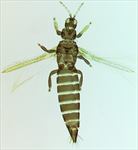
Female

Antenna
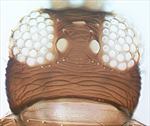
Head
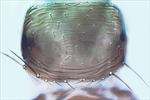
Pronotum
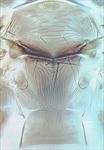
Meso & metanota

Tergites VII-VIII
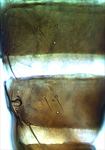
Tergites VII–VIII

Female sternites
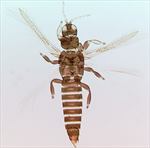
Male
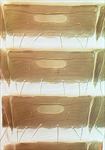
Male sternites

Fore wing
Both sexes fully winged. Body and legs brown, tarsi and apex of fore tibiae yellow; antennal segments I–II dark brown, VI–VII light brown, III–V mainly yellow with apices shaded; fore wings light brown. Antennae 7-segmented; segments III & IV each with a forked sense cone. Head as wide as long, 2 pairs of ocellar setae; pair III small, arising on anterior margins of ocellar triangle; postocular setae I & III longer than II & IV. Pronotum with transverse lines of sculpture; 2 pairs of posteroangular setae, 3 pairs of posteromarginal setae. Metanotum with narrow longitudinal reticulation on posterior half, irregular lines at anterior; median setae close to anterior margin; campaniform sensilla absent. Fore wing first vein with 3 setae on distal half; second vein with row of about 12 setae. Abdominal tergite II with 3 lateral marginal setae; V–VIII with paired ctenidia, on VIII posteromesad to spiracles; tergite VIII posteromarginal comb complete, microtrichia slender; pleurotergites without discal setae. Sternite II with 2 pairs of marginal setae, III–VII with 3 pairs; sternite II without discal setae, III–VII with about eight discal setae in irregular transverse row.
Male as dark as female but smaller; tergite VIII posterior margin with no comb; sternites III–VII with broadly oval pore plate.
Females of T. trehernei are very similar to the females of T. physapus Uzel, the common European species that is the type-species of this genus, but they have slightly longer pronotal setae. However, the males of T. physapus are yellow, whereas those of T. trehernei are brown. The genus Thrips is the second largest genus in the Thysanoptera, and currently includes, worldwide, about 295 species. All members of genus Thrips lack ocellar setae I on the head, and they all have ctenidia on tergite VIII posteromesad to the spiracles. Other characters, such as number of antennal segments, number of setae on the fore wing veins, and number of discal setae on the sternites are variable between species (Palmer, 1992; Nakahara, 1994; Mound & Masumoto, 2005).
Breeding in the flowers of various species of Asteraceae.
Originally from Western Europe and widespread across Europe, also in North America as far south as Georgia and California (Nakahara, 1994), and southeastern Australia (Mound & Masumoto, 2005).
THRIPIDAE - THRIPINAE
Thrips trehernei Priesner
Thrips trehernei Priesner, 1927: 356
Thrips magna Priesner, 1927: 355
Thrips taraxaci Moulton, 1936: 109
Thrips hukkineni Priesner, 1937: 108.
Mound LA & Masumoto M (2005) The genus Thrips (Thysanoptera, Thripidae) in Australia, New Caledonia and New Zealand. Zootaxa 1020: 1–64.
Nakahara S (1994) The genus Thrips Linnaeus (Thysanoptera: Thripidae) of the New World. United States Department of Agriculture. Technical Bulletin 1822: 1–183.
Palmer JM (1992) Thrips (Thysanoptera) from Pakistan to the Pacific: a review. Bulletin of the British Museum (Natural History) Entomology Series 61 (1): 1–76.